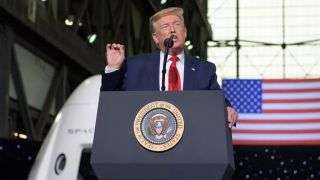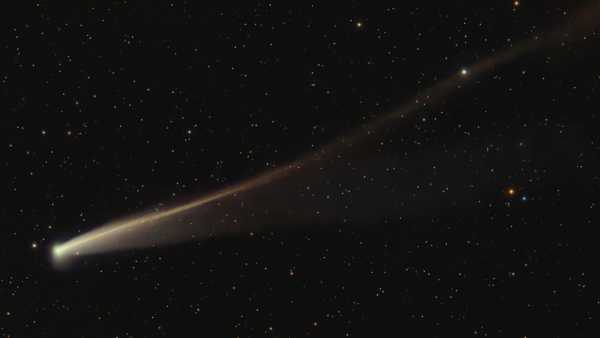
President Donald Trump speaks inside the Vehicle Assembly Building following the launch of a SpaceX Falcon 9 rocket carrying the company’s Crew Dragon spacecraft on NASA’s SpaceX Demo-2 mission with NASA astronauts Robert Behnken and Douglas Hurley onboard, Saturday, May 30, 2020, at NASA’s Kennedy Space Center in Florida.
President Donald Trump took to Twitter Wednesday (Aug. 5) to announce that he brought NASA back from being “Closed & Dead.”
In a tweet posted Wednesday, Trump said that he had resurrected the space agency. But the claim doesn’t hold up under scrutiny: NASA has never closed since it was founded in 1958, and it has certainly never been “dead.”
“NASA was Closed & Dead until I got it going again,” Trump wrote in the tweet. “Now it is the most vibrant place of its kind on the Planet…And we have Space Force to go along with it. We have accomplished more than any Administration in first 3 1/2 years. Sorry, but it all doesn’t happen with Sleepy Joe!”
NASA was Closed & Dead until I got it going again. Now it is the most vibrant place of its kind on the Planet…And we have Space Force to go along with it. We have accomplished more than any Administration in first 3 1/2 years. Sorry, but it all doesn’t happen with Sleepy Joe! https://t.co/PRebGIEJaqAugust 5, 2020
Many on Twitter have been quick to point out the inconsistencies and factual inaccuracies in this tweet, which also includes a reference to presumptive Democratic presidential nominee Joe Biden.
One of the most obvious errors in Trump’s statement is that NASA was “closed” or somehow inactive or “dead” before his administration. This is simply not the case, and it ignores a basic truth about big-ticket spaceflight projects: they require substantial timelines to come to life.
For example, NASA’s move to embrace and grow commercial spaceflight took off during the administration of President George W. Bush, with the establishment of the Commercial Cargo Program in 2006. That program has been quite successful: Two different robotic resupply craft — SpaceX’s Cargo Drago capsule and Northrop Grumman’s Cygnus vehicle — now routinely fly uncrewed cargo missions to the space station for NASA.
The Commercial Crew Program got going in 2010 under Trump’s predecessor, Barack Obama (whom Biden served as vice president). Commercial Crew has nurtured the development of SpaceX’s Crew Dragon vehicle, which just wrapped up the company’s first crewed mission, the Demo-2 test flight to the space station.
Many NASA robotic exploration efforts have been in the works for a long time as well. For instance, NASA’s Mars 2020 Perseverance rover launched last week, but research and development for the mission started much earlier. NASA launched an Announcement of Opportunity for researchers to pitch and develop the instruments and tools for the rover in September 2013.
The Obama administration also began development of the Orion crew capsule, which is set to be used for future moon-bound astronauts as part of NASA’s current Artemis program, which aims to land humans on the moon again by 2024. That capsule will launch on NASA’s massive Space Launch System, which also traces its roots to the Obama administration.
Before this, NASA’s space shuttle program was pioneered under the Nixon administration. In 1972, President Richard Nixon signed a bill authorizing $5.5 million to develop a space shuttle. This program continued on through presidents Gerald Ford, Jimmy Carter, Ronald Reagan, George H. W. Bush, Bill Clinton, George W. Bush and Barack Obama. The program officially ended in 2011.
Preceding this lengthy program, President John F. Kennedy initiated America’s first achievements in human spaceflight, first with Project Mercury and subsequently the Gemini program and Apollo program, the last of which came to fruition under Nixon.
So, in short, stating that the Trump administration is solely responsible for progress being made in the space sector would directly contrast with the infrastructure, foundation and progress that has been achieved over the decades throughout a number of presidential administrations.
One bit Trump’s tweet is based on facts, however: the U.S. Space Force was indeed created during the Trump administration. While the U.S. already had Air Force Space Command, which is integrated into the U.S. Air Force, the Space Force was officially established in December 2019.
President Trump has also sought to boost NASA’s budget during his years in office. This past February, for example, the White House’s federal budget request allocated NASA $25.2 billion, a 12% increase over the agency’s 2020 funding (though it’s unclear how much Congress will end up actually giving the space agency).
The final detail of the Trump tweet that has received scrutiny is the video attached to it, which shows SpaceX’s Starship SN5 prototype vehicle completing a roughly 500-foot-high (150 meters) test hop in Boca Chica, Texas, yesterday (Aug. 4). Starship SN5 is a full-size prototype of SpaceX’s Starship spacecraft, which the company aims to use for future crewed missions to Mars.
Many were confused by the included video, which was tweeted by Chris Bergin of NASASpaceflight.com, because it showcases a private SpaceX effort, not NASA activity. NASA and SpaceX work together frequently — SpaceX is even working with NASA to develop its Starship vehicle for future crewed lunar landings as part of NASA’s Human Landing System (HLS) program — but this test flight was a SpaceX endeavor.
Email Chelsea Gohd at [email protected] or follow her on Twitter @chelsea_gohd. Follow us on Twitter @Spacedotcom and on Facebook.
Sourse: www.livescience.com





